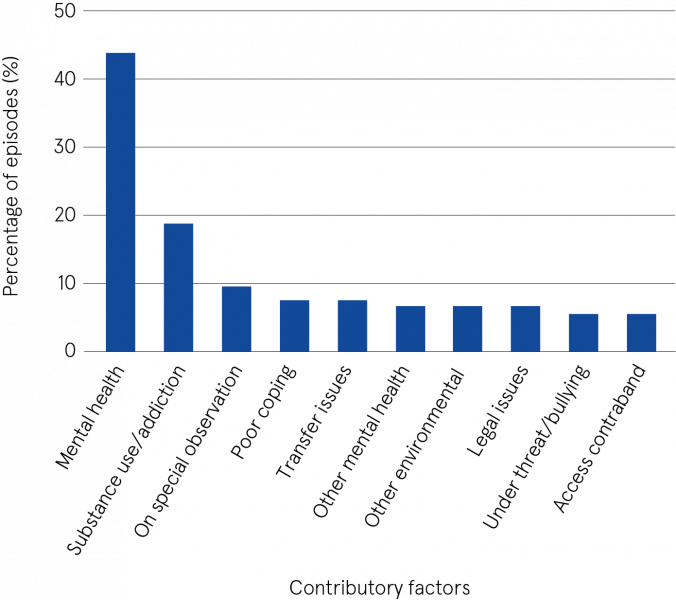Millar, Sean  ORCID: https://orcid.org/0000-0003-4453-8446
(2023)
Self-harm in Irish prisons, 2017–2019.
Drugnet Ireland,
Issue 86, Summer 2023,
pp. 35-36.
ORCID: https://orcid.org/0000-0003-4453-8446
(2023)
Self-harm in Irish prisons, 2017–2019.
Drugnet Ireland,
Issue 86, Summer 2023,
pp. 35-36.
| Preview | Title | Contact |
|---|---|---|
|
PDF (Drugnet Ireland 86)
1MB |
The Self-Harm Assessment and Data Analysis (SADA) Project was set up in Ireland in 2016 to provide robust information relating to the incidence and profile of self-harm within prison settings as well as individual-specific and context-specific risk factors relating to self-harm.
In addition, it examines patterns of repeat self-harm (non-fatal and fatal). Both the Health Service Executive’s National Office for Suicide Prevention and the National Suicide Research Foundation assist the Irish Prison Service with data management, data analysis, and reporting.
A 2023 study aimed to identify specific characteristics of self-harming behaviour and to establish a profile of prisoners who engage in self-harm.1
In the study, published in the International Journal of Prisoner Health, data from the SADA Project on self-harm episodes in prisons in the Republic of Ireland during 2017–2019 were used. Annual rates per 1,000 prisoners were calculated by age and sex.
Episodes of self-harm
Between 1 January 2017 and 31 December 2019, there were 696 episodes of self-harm recorded in Irish prisons, involving 397 individuals (328 males vs 69 females). The rate of self-harm between 2017 and 2019 was 31 per 1,000 prisoners for males and six times higher for females, at 184 per 1,000 prisoners. The highest rates of self-harm among sentenced prisoners were observed among 18–29-year-old men (45 per 1,000) and women (125 per 1,000). The rate of self-harm was found to be higher among female prisoners than males in all age groups.
Characteristics of self-harm
The most frequently used method of self-harm for sentenced prisoners was self-cutting or scratching (65%), most prevalent among young people aged 18–29 years (31%). The other common method of self-harm among sentenced prisoners was hanging (20%), most frequently recorded among males aged 18–29 years (9%) and females aged 30–39 years (15%), although this was based on small numbers.
Females were more likely to engage in hanging than males (33% vs 16%; p<0.001); however, a greater proportion of males who engaged in hanging had high levels of intent compared with females (81% vs 20%; p<0.001). Almost one-third (30.5%; n=121) of individuals engaged in self-harm more than once during the study period. Repetition was more pronounced for females (39.1%; n=27) than for males (28.7%; n=94).
For almost one-third (32%) of self-harm episodes, no medical treatment was required. One-half of all episodes (52%) required minimal medical intervention or minor dressings or local wound management. One in eight required hospital outpatient or emergency department treatment (13%). Severity of self-harm was greater for males than females, with a higher proportion of episodes by men requiring outpatient treatment (15% vs 7%, p<0.001) and hospitalisation/intensive care unit/loss of life (4% vs 1%, p<0.001). One in eight non-fatal episodes (13%) were of high intent. Males were more likely to engage in self-harm of high intent than females (16% vs 6% p<0.001). Three per cent of episodes were deemed to be associated with high severity (n=24).
Contributory factors
The most common contributory factors to self-harm are shown in Figure 1. The majority of contributory factors recorded related to mental health issues. Substance use and drug addiction was the second most common factor recorded.

Source: McTernan et al. 20231
Figure 1: Most common contributory factors to self-harm in prisons, 2017–2019
Conclusions
The authors noted that the Irish Prison Service has progressed to an expert-led and research-based implementation plan for a targeted and bespoke response to self-harm in prisons. However, further population and specific priority-group strategies with multiagency collaboration, incorporating a prison-wide approach with targeted interventions aimed at high-risk prisoners, are required to further reduce the incidence of self-harm in Irish prisons.
1 McTernan N, Griffin E, Cully G, Kelly E, Hume S and Corcoran P (2023) The incidence and profile of self-harm among prisoners: findings from the Self-Harm Assessment and Data Analysis Project 2017–2019. Int J Prison Health, Early online. Available from: https://www.drugsandalcohol.ie/38716/
F Concepts in psychology > Behaviour > Self-destructive behaviour / self-harm > Suicidal behaviour / suicide
J Health care, prevention, harm reduction and treatment > Health care programme, service or facility > Prison-based health service
MM-MO Crime and law > Justice system > Correctional system and facility > Prison
T Demographic characteristics > Person in prison (prisoner)
VA Geographic area > Europe > Ireland
Repository Staff Only: item control page